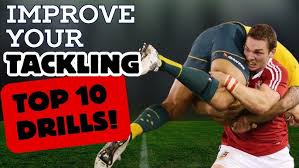Tackling is one of the most crucial and dangerous components of rugby. It requires a blend of raw strength, perfect timing, refined technique, and nerves of steel. At the professional level, where games can be decided by a single missed tackle, players dedicate enormous effort to mastering this fundamental skill. But what separates an average tackler from an elite one? It turns out, the secret lies in much more than physical power.
1. Mastering the Fundamentals: Body Positioning and Stance
Every great tackle starts before contact is made. Coaches at the professional level drill body positioning into their players from day one. The key lies in the “power stance”: feet shoulder-width apart, knees slightly bent, back flat, and eyes fixed on the ball carrier’s midsection usually their hips, which are the most honest indicator of movement.
This position sets the player up for success. It ensures balance and stability, reducing the chance of being side-stepped or fending off awkwardly. Elite players learn to “load” their legs like springs, ready to explode into a tackle with maximum power and minimum risk of injury.
2. Reading the Game: Timing and Tactical Awareness
Raw strength is useless without the brain to match. Top-level tacklers are exceptional readers of the game. Through constant film analysis, scenario drills, and match experience, they develop the ability to anticipate rather than react.
Do they charge in early to stop the offload? Or wait, let the attacker commit, and go low for a textbook leg tackle? Elite players often recognize subtle cues changes in pace, foot positioning, or even eye movement that help them make split-second decisions under pressure.
This kind of anticipation can’t be taught overnight; it comes from hours of studying opponents and an in-depth understanding of the game’s rhythm and flow.
3. Power from the Core: Strength and Conditioning
While rugby is often associated with upper-body strength, professional tacklers know that true tackling power comes from the core and lower body. Strength and conditioning coaches build routines that target:
- Leg drive (for post-contact meters and pushing back attackers)
- Core stability (for balance during awkward tackles)
- Explosive strength (to initiate contact quickly)
- Neck and shoulder durability (to absorb and deliver hits safely)
Players incorporate Olympic lifts, sled pushes, and plyometric drills into their training to develop the explosiveness needed to dominate in contact situations.
4. Technique Meets Safety: Tackling the Right Way
With increasing focus on player welfare and concussion prevention, top-tier players now work just as hard on safe tackling as they do on hard tackling. Modern rugby prioritizes:
- Head positioning: “Cheek to cheek” (head behind the ball carrier) is the rule to avoid dangerous head clashes.
- Shoulder-first contact: Hitting with the shoulder (not the head or chest) transfers force effectively.
- Arm wrap: Ensuring the arms wrap around the ball carrier, as per World Rugby’s legal requirements.
Players who consistently tackle high or recklessly risk not only penalties and cards, but serious injury. That’s why top teams bring in specialists, including wrestling coaches and biomechanists, to fine-tune safe, effective tackling mechanics.
5. Repetition, Repetition, Repetition
Technique doesn’t stick without repetition. At the elite level, players go through hundreds of tackle reps each week drilling specific scenarios like one-on-one tackles, choke tackles, or chop tackles. This builds muscle memory so that, in the heat of a game, their body instinctively knows what to do.
Coaches often simulate real-game conditions fatigue, bad weather, unusual angles to make sure tackling technique holds up when it counts most.
In fact, some clubs use virtual reality and AI tracking to give players feedback on tackle speed, angle, and impact bringing sports science directly into the heart of skill development.
6. Mental Toughness and Confidence
Tackling is as much a psychological battle as a physical one. Doubt or hesitation—even for a second—can lead to a missed tackle or a bad injury. That’s why elite players work on mindset just as much as they do on mechanics.
Visualization techniques, confidence-building drills, and controlled aggression are all part of the mental preparation that fuels a great defender. Knowing you can bring down anyone whether it’s a 120kg forward or a slippery winger comes from consistent training and trust in your technique.
The Art and Science of Tackling
Tackling at the top level isn’t about who’s the biggest or strongest it’s about who’s the smartest, most disciplined, and most committed to perfecting every detail. From mastering their body position to training under fatigue, elite rugby players leave nothing to chance.
They don’t just tackle they engineer each contact moment with precision. In a sport where the margins are razor-thin, that commitment to craft makes all the difference. And that, ultimately, is the secret behind how rugby’s best tacklers dominate the game one hit at a time.

